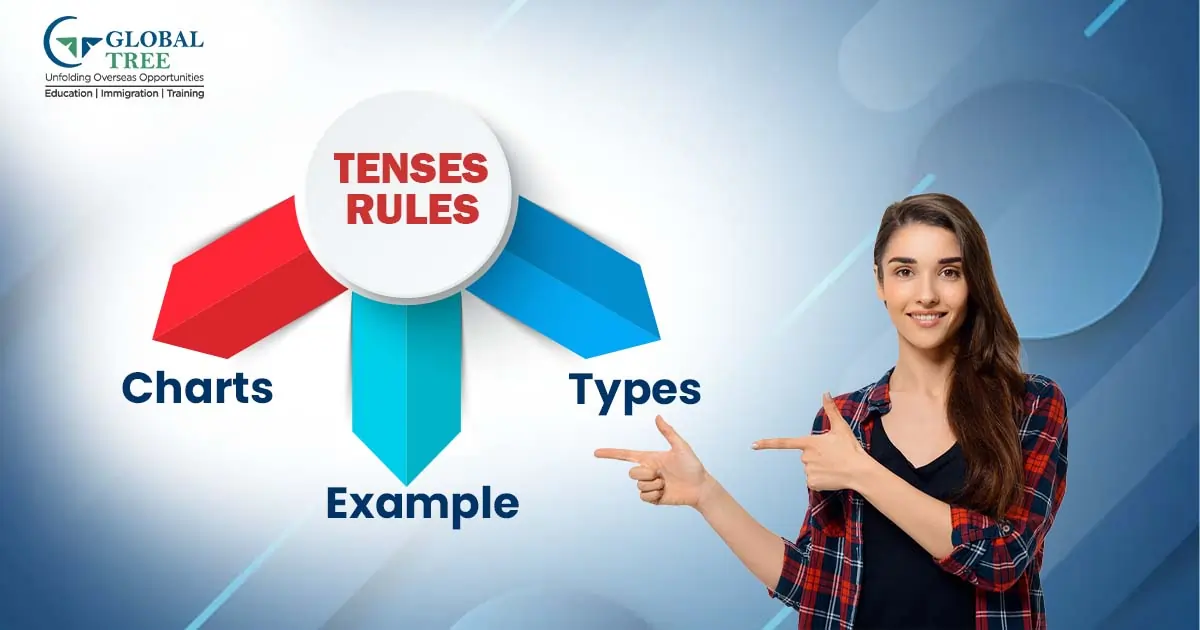English Tenses Made Easy: Rules, Charts & Examples for Beginners (2026)

- What are Tenses in English?
- 12 Tenses Types
- 12 Tenses Rules with Examples
- 12 Tense Rules Chart in Hindi
- Present Tense Rules and Examples
- Past Tense Rules and Examples
- Future Tense Rules and Examples
- Tenses Rules and Application
- Examples of Each Type of Tense
- Practice with Tenses Rules Quiz Questions!
- FAQs
What are Tenses in English?
Tenses are grammatical categories that specify the time of action, event, or state expressed by a verb. They are essential for conveying the timing of the verb's action, allowing speakers and writers to indicate whether an event occurred in the past, is occurring in the present, or will occur in the future.
12 Tenses Types
In English, there are three primary tenses: past, present, and future. Each of these tenses is further divided into four aspects: simple, continuous (progressive), perfect, and perfect continuous. This results in a total of twelve main types of tenses:
- Simple Present
- Present Continuous
- Present Perfect
- Present Perfect Continuous
- Present Indefinite Tense
- Simple Past
- Past Continuous
- Past Perfect
- Past Perfect Continuous
- Simple Future
- Future Continuous
- Future Perfect
- Future Perfect Continuous
- Tenses Rules Chart
12 Tenses Rules with Examples
To understand the tenses better and improve your English Skills, let's break them down into a comprehensive chart.
| Tense | Structure | Example Sentence |
|---|---|---|
|
Simple Present |
Subject + base verb (s/es for third person singular) |
She writes every day. |
|
Present Continuous |
Subject + am/is/are + verb-ing |
She is writing now. |
|
Present Perfect |
Subject + has/have + past participle |
She has written a letter. |
|
Present Perfect Continuous |
Subject + has/have been + verb-ing |
She has been writing for an hour. |
|
Simple Past |
Subject + past form of verb |
She wrote a letter yesterday. |
|
Past Continuous |
Subject + was/were + verb-ing |
She was writing a letter. |
|
Past Perfect |
Subject + had + past participle |
She had written a letter. |
|
Past Perfect Continuous |
Subject + had been + verb-ing |
She had been writing for an hour. |
|
Simple Future |
Subject + will + base verb |
She will write a letter tomorrow. |
|
Future Continuous |
Subject + will be + verb-ing |
She will be writing a letter. |
|
Future Perfect |
Subject + will have + past participle |
She will have written a letter. |
|
Future Perfect Continuous |
Subject + will have been + verb-ing |
She will have been writing for an hour. |
[Suggest Read: List of Idioms with Examples]
12 Tense Rules Chart in Hindi
| Tense | Structure (Hindi) | Example Sentence (Hindi) |
|---|---|---|
|
Simple Present |
कर्ता + क्रिया की मूल रूप (तीसरे व्यक्ति एकवचन के लिए s/es) |
वह हर दिन लिखती है। |
|
Present Continuous |
कर्ता + am/is/are + क्रिया-ing |
वह अभी लिख रही है। |
|
Present Perfect |
कर्ता + has/have + क्रिया का भूतकालीन रूप |
उसने एक पत्र लिखा है। |
|
Present Perfect Continuous |
कर्ता + has/have been + क्रिया-ing |
वह एक घंटे से लिख रही है। |
|
Simple Past |
कर्ता + क्रिया का भूतकालीन रूप |
उसने कल एक पत्र लिखा। |
|
Past Continuous |
कर्ता + was/were + क्रिया-ing |
वह एक पत्र लिख रही थी। |
|
Past Perfect |
कर्ता + had + क्रिया का भूतकालीन रूप |
उसने एक पत्र लिखा था। |
|
Past Perfect Continuous |
कर्ता + had been + क्रिया-ing |
वह एक घंटे से लिख रही थी। |
|
Simple Future |
कर्ता + will + क्रिया की मूल रूप |
वह कल एक पत्र लिखेगी। |
|
Future Continuous |
कर्ता + will be + क्रिया-ing |
वह एक पत्र लिख रही होगी। |
|
Future Perfect |
कर्ता + will have + क्रिया का भूतकालीन रूप |
उसने एक पत्र लिखा होगा। |
|
Future Perfect Continuous |
कर्ता + will have been + क्रिया-ing |
वह एक घंटे से लिख रही होगी। |
[Suggest Read: Best Books to improve your Vocabulary]
Present Tense Rules and Examples
Simple Present Tense Rules
Structure: Subject + base form of the verb (add 's' or 'es' for third person singular)
Usage: Used to describe habitual actions, general truths, and fixed arrangements.
Examples:
- He plays tennis every Sunday.
- Water boils at 100 degrees Celsius.
- The train leaves at 6 PM.
Present Continuous Tense Rules
Structure: Subject + am/is/are + verb-ing
Usage: Used to describe actions that are happening at the moment of speaking or temporary situations.
Examples:
- She is reading a book now.
- They are working on the project this week.
- I am waiting for the bus.
Present Perfect Tense Rules
Structure: Subject + has/have + past participle
Usage: Used to describe actions that have occurred at an unspecified time in the past and are relevant to the present, or actions that started in the past and continue to the present.
Examples:
- She has visited Paris.
- We have known each other for ten years.
- I have just finished my homework.
Present Perfect Continuous Tense Rules
Structure: Subject + has/have been + verb-ing
Usage: Used to describe actions that started in the past and are still continuing or actions that have recently stopped but have a result in the present.
Examples:
- He has been running for an hour.
- They have been living here since 2010.
- I have been studying for the exam all day.
Past Tense Rules and Examples
Simple Past Tense Rules
Structure: Subject + past form of the verb
Usage: Used to describe actions that occurred and were completed at a specific time in the past.
Examples:
- She wrote a letter yesterday.
- They visited the museum last week.
- I saw him at the party.
[You may also like: Top Synonyms List to Strengthen Your Vocabulary]
Past Continuous Tense Rules
Structure: Subject + was/were + verb-ing
Usage: Used to describe actions that were ongoing at a specific time in the past.
Examples:
- She was reading when I called.
- They were playing football at 6 PM.
- I was cooking dinner when the doorbell rang.
Past Perfect Tense Rules
Structure: Subject + had + past participle
Usage: Used to describe actions that were completed before another action in the past.
Examples:
- She had finished her homework before she went out.
- By the time we arrived, they had left.
- I had seen the movie before.
Past Perfect Continuous Tense Rules
Structure: Subject + had been + verb-ing
Usage: Used to describe actions that were ongoing in the past up until another point in the past.
Examples:
- She had been working there for five years before she moved.
- They had been arguing all morning.
- I had been waiting for an hour when the train finally arrived.
Future Tense Rules and Examples
Simple Future Tense Rules
Structure: Subject + will + base form of the verb
Usage: Used to describe actions that will occur in the future.
Examples:
- She will write a letter tomorrow.
- They will travel to Japan next month.
- I will help you with your homework.
Future Continuous Tense Rules
Structure: Subject + will be + verb-ing
Usage: Used to describe actions that will be ongoing at a specific time in the future.
Examples:
- She will be working at 8 PM.
- They will be studying all night.
- I will be waiting for you.
Future Perfect Tense Rules
Structure: Subject + will have + past participle
Usage: Used to describe actions that will be completed before a specific time in the future.
Examples:
- She will have finished her homework by 9 PM.
- They will have left by the time we arrive.
- I will have completed the project by next week.
Future Perfect Continuous Tense Rules
Structure: Subject + will have been + verb-ing
Usage: Used to describe actions that will be ongoing up until a specific time in the future.
Examples:
- She will have been working for five hours by then.
- They will have been living here for ten years next month.
- I will have been studying for three hours by the time you get here.
Tenses Rules and Application
Understanding and correctly applying tense rules is crucial for clear and effective communication in English. Here are some general tips:
- Identify the time frame: Determine if the action is in the past, present, or future.
- Choose the correct aspect: Decide if the action is simple, continuous, perfect, or perfect continuous.
- Be consistent: Maintain the same tense throughout a sentence or paragraph unless there's a shift in the time frame.
[Read More: What is the most hardest Language in the world?]
Examples of Each Type of Tense
Here are examples illustrating each type of tense in different contexts:
- Simple Present: She teaches English.
- Present Continuous: She is teaching English now.
- Present Perfect: She has taught English for ten years.
- Present Perfect Continuous: She has been teaching English since morning.
- Simple Past: She taught English yesterday.
- Past Continuous: She was teaching English at 9 AM.
- Past Perfect: She had taught English before she moved here.
- Past Perfect Continuous: She had been teaching English for two hours when I called.
- Simple Future: She will teach English tomorrow.
- Future Continuous: She will be teaching English at 9 AM.
- Future Perfect: She will have taught English by the time you arrive.
- Future Perfect Continuous: She will have been teaching English for three hours by noon.
Practice with Tenses Rules Quiz Questions!
Test your understanding of tenses with these quiz questions:
- Simple Present: They (go) to school every day. [Answer: go]
- Present Continuous: She (read) a book right now. [Answer: is reading]
- Present Perfect: I (complete) my homework. [Answer: have completed]
- Present Perfect Continuous: We (live) here for five years. [Answer: have been living]
- Simple Past: He (finish) his work yesterday. [Answer: finished]
- Past Continuous: They (play) football when it started to rain. [Answer: were playing]
- Past Perfect: She (leave) before I arrived. [Answer: had left]
- Past Perfect Continuous: They (work) for an hour before the meeting started. [Answer: had been working]
- Simple Future: I (travel) to Paris next week. [Answer: will travel]
- Future Continuous: She (work) at 10 AM tomorrow. [Answer: will be working]
- Future Perfect: They (finish) the project by next Monday. [Answer: will have finished]
- Future Perfect Continuous: By the end of this year, she (study) for ten years. [Answer: will have been studying]
[Suggested Read: Use these Idioms to make your English more Professional]
FAQs
Q: How do I choose the correct tense?
A: Determine the time frame (past, present, future) and the aspect (simple, continuous, perfect, perfect continuous) based on the context and nature of the action.
Q: What is the difference between present perfect and present perfect continuous?
A: Present perfect indicates an action completed at an unspecified time or an action starting in the past and continuing to the present. Present perfect continuous emphasizes the duration of an ongoing action that started in the past and continues to the present.
Q: Can I mix tenses in a sentence?
A: Yes, but it should be done to indicate a change in the time frame or context. Consistency is crucial within the same context.
By mastering the rules of tenses, you'll enhance your ability to communicate clearly and effectively in English. Practice regularly to internalize these concepts and use them naturally in your writing and speaking.


